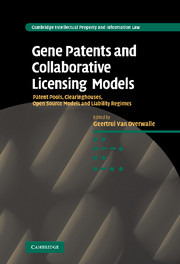 Gene Patents and Collaborative Licensing Models
Gene Patents and Collaborative Licensing Models Book contents
- Frontmatter
- Contents
- List of contributors
- Preface
- Foreword: Jean-Jacques Cassiman
- List of abbreviations
- Part I Patent pools
- Part II Clearinghouses
- Part III Open source models
- Part IV Liability regimes
- Part V Different perspectives
- 20 Gene patents: from discovery to invention. A geneticist's view
- 21 ‘Patent tsunami’ in the field of genetic diagnostics. A patent practitioner's view
- 22 Gene patents and clearing models. Some comments from a competition law perspective
- 23 Access to genetic patents and clearing models. An economic perspective
- 24 The role of law, institutions and governance in facilitating access to the scientific research commons. A philosopher's perspective
- Part VI Summary and concluding analysis
- Index
- Titles in the series
23 - Access to genetic patents and clearing models. An economic perspective
from Part V - Different perspectives
Published online by Cambridge University Press: 14 January 2010
- Frontmatter
- Contents
- List of contributors
- Preface
- Foreword: Jean-Jacques Cassiman
- List of abbreviations
- Part I Patent pools
- Part II Clearinghouses
- Part III Open source models
- Part IV Liability regimes
- Part V Different perspectives
- 20 Gene patents: from discovery to invention. A geneticist's view
- 21 ‘Patent tsunami’ in the field of genetic diagnostics. A patent practitioner's view
- 22 Gene patents and clearing models. Some comments from a competition law perspective
- 23 Access to genetic patents and clearing models. An economic perspective
- 24 The role of law, institutions and governance in facilitating access to the scientific research commons. A philosopher's perspective
- Part VI Summary and concluding analysis
- Index
- Titles in the series
Summary
Introduction
Several institutions have been identified as mechanisms that can be used to facilitate access to genetic patents: research exemptions, compulsory licensing, patent pools, various clearinghouses and open source collectives. Following van Zimmeren, a major distinction between mechanisms “for access” and mechanisms “for access and use” can be made. Applying an economic logic, however, leads to a subcategorization which differs from van Zimmeren's classification, and leads to subdividing the second category into collective rights organizations (CRO) and incomplete contract structures (ICS). Incomplete contract structures is expansion of open source and includes contractually structured liability.
Each category has a different purpose: “for access” clearing mechanisms are characterized by network and transaction cost reduction, CROs set prices to IP so that they will be used optimally for production, and ICSs address incontractable, uncertain and dynamic nature of innovation. While there are working examples of the aforementioned systems, we will also discuss the contractually constructed liability regime which is a new concept.
We categorize the clearing mechanisms by function. Mechanisms such as “information clearinghouses” (information CH) and “technology exchange clearinghouses” (technology exchange CH) are “for access” and purely for exchange. The purpose of information CH is for IP or technology owners to disseminate and the potential users to find the information about the technology. Technology exchange CH go one step further in that technology is sold or licensed in addition. The property owners and users interact directly and property owners retain ownership.
- Type
- Chapter
- Information
- Gene Patents and Collaborative Licensing ModelsPatent Pools, Clearinghouses, Open Source Models and Liability Regimes, pp. 350 - 364Publisher: Cambridge University PressPrint publication year: 2009
- 2
- Cited by


